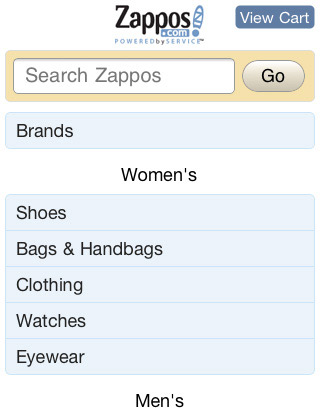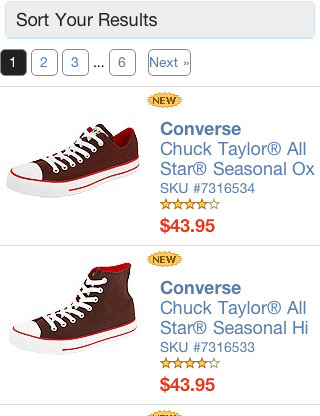The average global eCommerce conversion rate is 2.58%.
Does that mean for every 100 visitors on your eCommerce website, 2.58 (!) of them would make a purchase?
Not really.
It depends.
On a lot of factors.
- Like the device that your visitors are using. Mobile devices have a slightly lower rate of conversion (average 2% in Q2, 2022) as compared to desktops, tablets, and laptops (average 3% in Q2, 2022).
- Or the kind of product your eStore sells. Food and beverage products have a 4.6% average conversion rate (Likely due to lower product cost). Electronics on the other hand have a lower average conversion rate of 1.9% (due to them being a costly purchase).
Now, if we talk about eCommerce leaders, their conversion rates vary. To put things into perspective,
- Amazon: Approximately 13%
- eBay: Around 5%
- Walmart: Roughly 3%
- Etsy: About 3.5%
While these eCommerce market leaders sell different products and have different strategies for driving conversions, there are some common eCommerce website features that they have.
These common eCommerce website elements are not just found in these four eCommerce sites, but also in the hundreds of top-performing eCommerce websites that we, at SynergyTop, have developed or analyzed.
What are those eCommerce website elements?
Read on to find out the top eCommerce features.
7 Must-Have eCommerce Elements For An eCommerce Website
While there are hundreds of elements on eCommerce websites that have an impact on user experience and conversions, some of the basic modules of eCommerce website development are discussed and explained in detail below.
Having or not having these eCommerce essentials can play a major role in the success or otherwise of your business.
1. Clear Navigation
Think of clear navigation as the friendly GPS of your online store. As an eCommerce functionality, it’s all about crafting menus, categories, and links that practically guide customers to their dream products.
Why is it such a big deal? Well, if visitors can’t figure out where to go, they might just bounce off to a competitor. So, make it smooth and easy – nobody wants to get lost in a digital shopping maze.
Some best practices while creating clear navigation for your eCommerce website include:
- Go for snappy menu labels,
- Use breadcrumbs on your site,
- Create logical categories, and
- Always give the search bar a spotlight.
Best Buy’s got this down pat. Their dropdown menus whisk you off to different departments without a hitch.
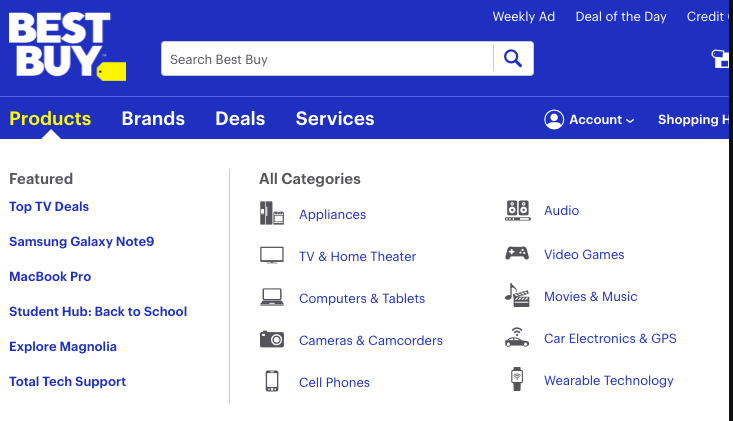
2. High-Quality Product Images
Imagine you’re in a store, and you pick up a product to examine it closely. That’s not possible when shopping online. But customers do expect some eCommerce features that would compensate for that. Images are the best way to do that.
Crisp, detailed, and well-lit pictures speak volumes about your products.
Why?
Because customers need to virtually touch and feel what they’re buying. Having eCommerce features that help people do that, build trust and wipe away those pesky doubts.
Here are the key things to keep in mind while adding product images to your eCommerce website:
- Use images from multiple angles to provide a 360-degree view.
- Allow the zoom features, and
- Add real-life context shots of your products so that your visitors get the ‘I can practically touch it’ feeling.
Fitbit, the international fitness technology label, is a force to reckon with in the context of such eCommerce features. They have top-tier, elegant product images on their website which show the intricacies of the products, along with their use in various real-life scenarios.

3. Detailed Product Descriptions
You can’t whisper sweet product details into your customers’ ears. What you can do is write them down – really well.
That’s why detailed descriptions are one of the most important eCommerce website features. These descriptions dive deep into specs, features, and why your product deserves to be brought. And since your visitors can’t physically hold the item, these words are your sales superheroes.
Here are some tips about creating product descriptions from the market leaders:
- Use bullet points for quick scans,
- Always highlight the unique selling points, and
- Make sure you also add product dimensions and care tips.
Sephora does an A+ job by providing exhaustive product details for makeup mavens to make informed choices.
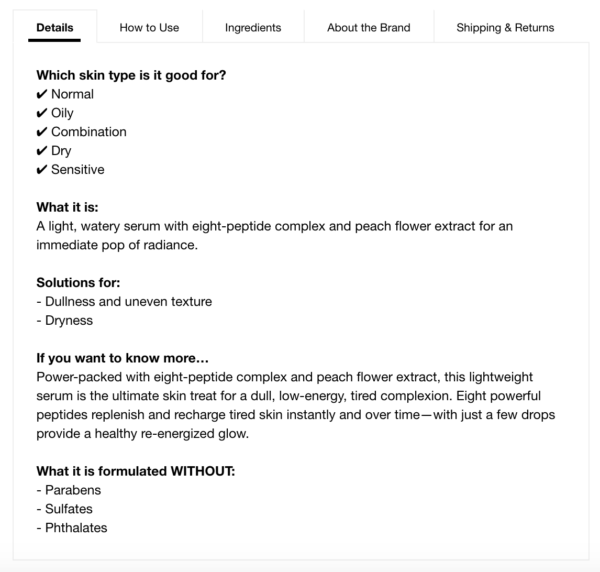
4. User Reviews and Ratings
Who would you trust more: a brand shouting how great their stuff is or a bunch of real people nodding in agreement?
The answer is obvious. Also, it is obvious that you have eCommerce features on your website which prove that your products are loved by others. Reviews and ratings give that much-needed social proof and paint a truer picture of what’s in store.
So it is best that you:
- Let the good and not-so-good reviews flow on your website.
- Give your customers an option to add star ratings,
- And use the “Verified Purchase” badge to keep things legit.
Etsy successfully leverages this eCommerce functionality. They tap into user reviews and ratings to show off the uniqueness and quality of their handcrafted treasures.
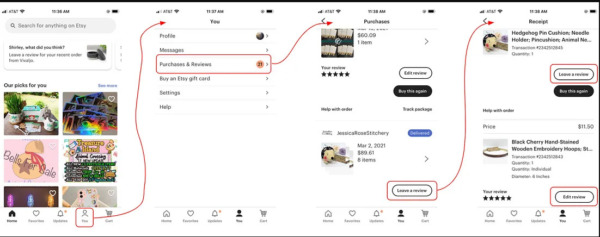
5. Secure Checkout
Alright, imagine giving your credit card to a random person on the street. Not happening, right?
Secure checkout is your digital bodyguard, making sure sensitive data stays locked away and payments are as safe as houses.
Here are three things to take care of for a secure checkout:
- SSL encryption is a must
- Offer a variety of secure payment options (Find out which payment methods are popular among your target audience and offer those)
- And you can also offer one-click social sign-in for faster checkouts.
ASOS, a fashion haven, lets customers strut their stuff online while keeping their data secure at checkout.
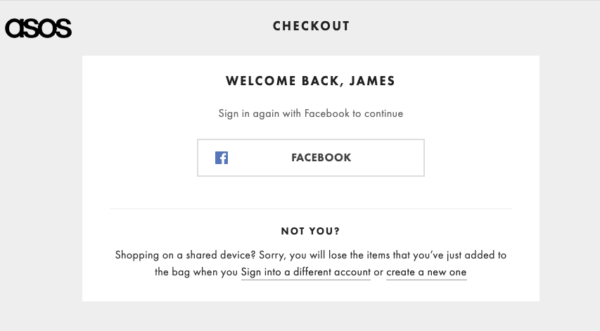
They also clearly show shipping and delivery details which further builds brand trust.
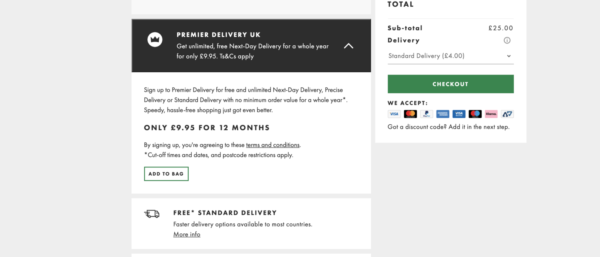
6. Search Functionality
Ever heard of the saying “searching high and low”? Well, now it’s just “searching.” A top-notch search bar lets customers hunt down products like a pro, without scrolling through endless pages.
Pro Tip: Instead of a regular search bar, consider using a smart search bar that uses intelligent logic and algorithms to help your visitors find exactly what they are looking for. Learn more about Smart Search Bars and how they can positively influence eCommerce conversion rates here.
The Smart Search Bar that we implemented on a US-based eCommerce website for restaurant supplies store has the following features:
- The smart search understands the search query, even with a typing error.

- Option to filter and sort the products.

- Search suggestions while the user is typing.
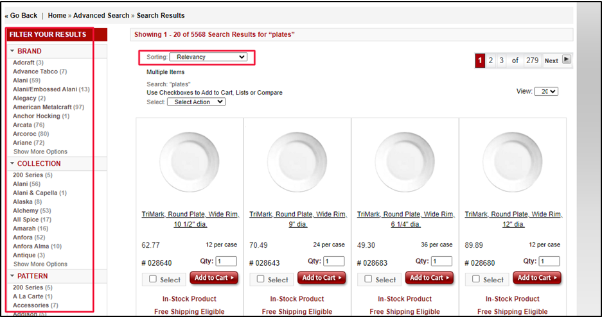
7. Responsive Design
Responsive design is another must-have element of an eCommerce website. And we cannot emphasis it enough.
No one likes squinting at their phone screen or feeling like they need a magnifying glass. So use responsive design to make your store look and work fabulously on any device, be it a smartphone or a desktop.
Start by embracing a mobile-first approach. And don’t forget to:
- Optimize everything for speedy mobile loading,
- And give your site a test drive on different gadgets.
Zappos’ responsive design is a commendable example.
Gearing Toward The Perfect eCommerce Website
Integrating these seven eCommerce essentials is your gateway to a conversion-optimized eCommerce website.
With these eCommerce website features, you not only create an enticing shopping environment but also enhance your chances of converting visitors into loyal customers.
However, effectively implementing these eCommerce essentials requires expertise in web development, design, user experience, and the basics of eCommerce. This is where partnering with eCommerce development experts becomes crucial.
Collaborating with professionals who understand the basics of eCommerce can ensure that your website is not only visually appealing but also functional and user-centric.
They can help you tailor these must-have elements to your specific target audience and industry. Rhis will result in a website that not only meets but exceeds user expectations.
Remember: In the competitive world of online retail, a successful eCommerce website goes beyond just selling products. It’s about providing a seamless, enjoyable, and trustworthy shopping experience for your customers.
With the right eCommerce website elements in place, your eCommerce venture is poised for growth and success.
At SynergyTop, we have experience working with over 250 eCommerce websites in a wide range of domains including hospitality, fashion, food & beverage, and more. So don’t wait, bank on our decade-long experience and build a high-converting eCommerce website with all essential eCommerce website features today!



